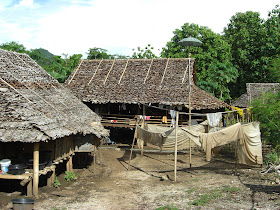The last half decade has seen a fairly drastic increase in funding directed towards eliminating or controlling malaria. Furthermore, according to WHO numbers, that funding has also been effective. In Sub-Saharan Africa, where malaria causes the greatest morbidity and mortality, the number of insecticide treated bednets available to households has gone up. And if the surveys are to be trusted, it also looks as though people who have access to these bednets are using them as bed nets. (This is always a problem as bednets can also be used for other great things such as fishing nets, table cloths, and I’ve even seen them stored outside so that large edible crickets can be caught and sold in the market place in Northern Thailand).
Other positive notes include an increased rate of diagnosis prior to administering antimalarials and the wide-spread adoption of ACTs (artemisinin combination therapies). ACTs are used rather than monotherapies with the hope that widespread resistance to artemisinin won’t emerge globally. On a negative note, it already has emerged in Southeast Asia and has been documented in four nations to date. A real concern is that artemisinin resistant parasites will find their way to Africa, perhaps following the same routes that chloroquine resistant parasites spread globally from Southeast Asia decades ago (presumably migrating through human reservoirs).
A not-so-surprising component of the report concerns where the actual improvements occur. Places with comparatively mild endemic malaria were the quickest at improving the situation. (It is easier to fix a small problem than to fix a really big problem). However, the greatest improvements in mortality and morbidity appear to have occurred in the places with the worst malaria burden. This makes some sense. If the money and resources were spread completely evenly across all malaria ridden nations (and such spatial homogeneity is almost never the case for anything) then we would find exactly such a finding, just because there are more sick and dying people in the nations where the malaria burden is the worst.
But now for some sobering considerations that even the WHO brings up. Those places where malaria is the worst are also the places with the worst malaria surveillance. That means that estimates from those places have the biggest confidence intervals. (Which means that estimates must be taken not only with my critical interpretation but also with more than a few grains of salt). Furthermore, it looks like the rate of increase of both funding and the rolling out of malaria-related services have reached plateaus. The overarching implication here is that things have been getting better, and they could continue to get better, but the future is very uncertain. Things could get worse again.
(I truly hope that things are getting much better and that they will continue to do so. Certainly in some parts of Southeast Asia where I work things have gotten better. They’ve probably gotten worse in other places and will continue to do so if other socio-political problems don’t cease (see my previous blog post on Northern Myanmar). I tend to be a real pessimist when it comes to malaria eradication. I’m completely hopeful that it will happen, but I have serious doubts that it will ever happen for most places or that it will remain that eradicated in places as the years go by. At this point, history supports my pessimism.)
This would probably be a good place to mention the mini academic spat that recently occurred over yearly malaria mortality estimates. Murray et al. estimated that around 1,238,000 people died from malaria in 2010. Given historical, long term trends this wouldn’t be that surprising except that the WHO’s annual report from 2011 estimated that things were getting much better and that around 655,000 people had died from malaria in 2010 [1–3]. Several scientists were quite bent out of shape over this discrepancy. Don’t get me wrong, a discrepancy of about half a million isn’t trivial. It just sometimes feels like the ‘right’ numbers (numbers that serve a purpose) can be more important than numbers that are more accurate scientifically. I’ve seen very similar arguments with regard to whether or not we should be talking about artemisinin resistance yet, since the drug is so important and there isn’t really widespread failure [4, 5]. I’ll not tread further into this debate.
But public/global health is part science and part marketing. It can be a tricky thing to try to convince people to throw money at problems that don’t appear to directly affect them. Numbers like what the WHO are throwing out could actually do it (and perhaps have been doing it in the last half decade). That doesn’t mean that I’m saying the WHO organization numbers are wrong. What I am saying is that it is a dramatic story that could pull on the heartstrings of wealthy donors. I favor science over marketing schemes, but, regardless of the validity of the WHO’s findings, I hope it does inspire people to continue funding global health efforts. A healthy world will be better for all of us.
References
1. Murray C, Rosenfeld L, Lim S, Andrews K, Foreman K, Haring D, Fullman N, Naghavi M, Lozano R, Lopez A: Global malaria mortality between 1980 and 2010: a systematic analysis. The Lancet 2012, 379:413–431.
2. WHO WHO: Malaria. Fact Sheet 2010, 2010.
3. Ye Y, Kyobutungi C, Ogutu B, Villegas L, Diallo D, Tinto H, Oduro A, Sankoh O: Malaria mortality estimates: need for agreeable approach. Tropical medicine & international health : TM & IH 2012, 00:10–12.
4. Meshnick S: Perspective: artemisinin-resistant malaria and the wolf. The American journal of tropical medicine and hygiene 2012, 87:783–4.
5. White NJ: Counter perspective: artemisinin resistance: facts, fears, and fables. The American journal of tropical medicine and hygiene 2012, 87:785.


No comments:
Post a Comment